
Prepared by:
R.L. Huffman
Extension Agricultural Engineering Specialist
Published by: North Carolina Cooperative Extension Service
Publication Number: AG 469
Last Electronic Revision: March 1996 (JWM)
Your well is more than just a hole in the ground; it is the source of water for you and your family. To ensure a safe and sufficient water supply, your well must be constructed properly. Wells draw water from aquifers, which are water-saturated layers of soil or rock. A well should be built so that only water from selected depths may enter and only the best available ground water is obtained. Proper well construction also helps prevent ground water contamination. Once your well is built, protection and management of the well and the area around it are necessary to maintain the quality of your water supply.
This publication briefly describes the different types of well construction common in North Carolina and then summarizes the state regulations governing construction and maintenance of private water supply wells. Code quotations are reproduced from the North Carolina Administrative Code, Title 15A, Subchapter 2C Well Construction Standards, Section .0100 "Criteria and standards applicable to water supply and certain other wells."
The type of construction needed depends largely on the local geology and the required yield. Yield is the rate at which water flows into the well during pumping — for example, 10 gallons per minute. Construction methods vary across the state. Table 1 lists the seven methods of construction common in North Carolina, along with typical size ranges and the soil or rock formations suitable for each.
------------------------------------------------------------------------------------
Drilled
Percussion Rotary
Characteristics Dug Bored Driven Jetted (Cable-tool) Hydraulic
Max. practical
depth 50ft 100ft 50ft 100ft 1000ft 1000ft
Diameter range 3-20ft 2-30in 1.25-2.5in 2-12in 4-18in 4-24in
Type of material:
Coastal Plain
Silt & & — - & &
Sand - — & & & &
Shell beds - — & ? ? &
Limestone — - ? - ? &
Piedmont and Mountain
Saprolite & & ? - & &
Bedrock ? - - - & &
Note: Question marks (?) indicate that the method may be suitable if cemented
layers or boulders are not encountered.
Source: Heath, R.C. 1980. Basic elements of ground water hydrology with
reference to conditions in North Carolina.
Rotary drilling uses drag or roller bits attached to the end of a rotating drill stem. In the hydraulic-rotary method, driller's mud, a slurry of water and clay, is circulated in the hole to cool the bits and remove cuttings. The air-rotary method uses compressed air instead of driller's mud. A number of other additives may be used by the driller, depending on the type of conditions encountered during well construction.
Drillers frequently specialize in one or two methods of well construction. If you plan to build a well, first find out what type of well is most appropriate for your needs. Then find a driller with the necessary equipment and experience. Figure 1 shows the basic features of drilled-well construction in settings typical to North Carolina.
Whatever the construction method, a well must be developed before it is placed in service. The development process maximizes flow to the well by removing any remnants from the drilling process and fine sediments from the vicinity of the intake. Gradually increasing the pumping rate to a level greater than the design yield will usually remove the sediments. In some cases, it may be necessary to apply high-pressure jets of water or air or to use surging (forcing water in and out of the formation) to dislodge the sediments. The state code requires that the well water contain no more than 5 milligrams of suspended solids (sediment particles) per liter.
State code also requires that "all water supply wells shall be disinfected upon completion of construction, maintenance, repairs, pump installation, and testing." This process kills disease organisms or iron bacteria that may have been introduced during the work. Calcium hypochlorite (such as HTH or Chlor-Tabs) should be added to obtain a 100 ppm chlorine residual in the well. This solution must stand in the well for a minimum of 24 hours. The well should then be pumped to flush out the chlorine. Drilling contractors can help to prevent bacterial contamination by washing their equipment with a chlorine solution between jobs. Before placing the well in service, a sample of the well water should be tested to ensure its safety.
Water can enter your well only by flowing "downhill." When your pump operates, it lifts the water that is inside the casing. By removing that water, it creates a valley in the surrounding ground water, which is known as a cone of depression. Nearby ground water can then flow down into this valley. The ease with which water can flow to the casing determines the yield of your well. Well yields tend to be high in the coastal plain where water can move very easily through sand, gravel, shells, or limestone. Water moves more slowly through the denser clay and rock of the piedmont and Blue Ridge regions, so well yields tend to be lower. In either case, anything that is inside the zone from which your well draws water—that is, within the cone of depression—will tend to move toward the well. Good management includes controlling contaminants within that zone. Figure 2 illustrates the path that a contaminant might take from the soil surface into a well.
The extent of the zone depends on the amount of pumping and on the characteristics of the well and of the local formations. Consider 100 feet in all directions from the well as a minimum area to be protect-ed. The zone generally reaches further upslope than downslope.
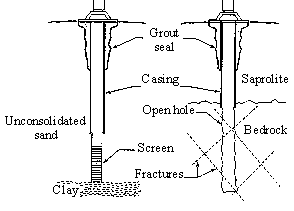
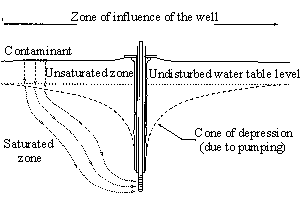
The purpose of a well is to tap a supply of clean water and transport that water in a sanitary manner to the point of use. (To succeed, the well must be construct-ed to exclude contaminants, which requires downhole and wellhead protection. Construction details that are important to protection of drilled, bored, and driven wells are shown in Figures 3, 4, and 5, respectively. Special exceptions to the details shown in those figures are discussed in the following section.
Downhole Protection
All wells require a casing. The casing is a solid pipe that stabilizes the formations and seals out undesirable water and contaminants. Stabilization is particularly necessary in unconsolidated formations such as sand, gravel, silt, clay, shell beds, and saprolite. Casings may also be used in hard rock wells to prevent rock fragments from sloughing into the well. In this situation, the casing in the rock may be slotted to allow free water movement.
In unconsolidated formations, perforated sections of pipe, called screens, are installed at the depths of the production zones. The screens allow free movement of water and keep sediment from entering the well. Sand or gravel may be packed around the outside of the screens to increase the effective diameter of the well, which generally increases the yield. Such packing is commonly used for high-yield municipal or irrigation wells.
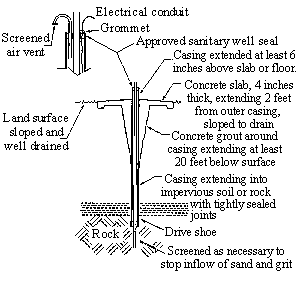
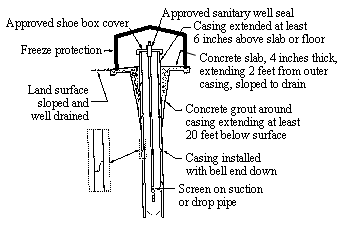
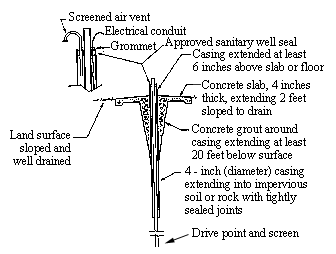
The state code requires that the casing extend at least 20 feet below the surface, except in the following cases:
Anson County: west of a line between the confluence of Buffalo Creek and the Peedee River and the southwest corner of the county.
Cabarrus County: anyplace within 3 miles of the Stanly County line.
Davidson County: south of a line between the confluence of Abbott's Creek and the Yadkin River and the intersection of US 64 and the Randolph County line.
Montgomery County: the western third of the county.
Randolph County: anyplace that is both south of US 64 and within 7 miles of the Davidson County line.
Rowan County: east of a line between Gold Hill and the confluence of Reedy Creek and the Yadkin River.
Stanly County: entire county.
Union County: all but the very western point near Mecklenburg County and the South Carolina line.
These designations are approximate. Exceptions may exist or be granted in other areas, depending on the specific site conditions. Consult your county Health Department for precise requirements at your location.
In constructing the well, the borehole should be made several inches larger than the casing. (Exact requirements depend on the type of construction. Some counties have more stringent regulations than the state. Check with your county Health Department.) After setting the casing, this leaves an open annular space between the casing and the formation, as shown in Figure 6. The annular space must be carefully and completely sealed to prevent vertical flow of water along the outside of the casing. A nonshrinking cement grout is the recommended material for this. (The regulations list specific mixes allowed.)

North Carolina well construction standards require that the casing be grouted to a minimum depth of 20 feet below the land surface. There are exceptions, however. Some areas are allowed a minimum of 10 feet; others require a minimum of 35 feet. The areas excepted are the same as those listed above for casing depths. In any case, "the casing shall be grouted as necessary to seal off all aquifers or zones with water of a poorer quality than that of the producing zones."
Surface waters and water in the upper soil are assumed to be of low quality. Thus, any well that is not grouted at the surface is in direct violation of the state code. The code also states, "In constructing any well, all water-bearing zones that are known to contain polluted, saline, or other nonpotable water shall be adequately cased and cemented off so that pollution of the overlying and underlying ground water zones will not occur." The driller is responsible for protecting the high-quality ground water from any sources of lesser quality water encountered in the construction of the well.
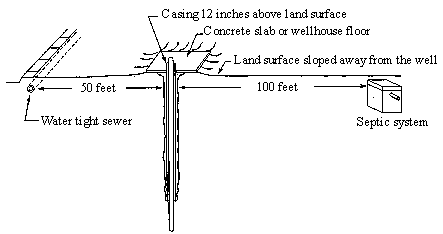
Wellhead Protection
The primary objective in protecting the wellhead is to keep surface waters and other possible contaminants away from the wellhead. The well site should be chosen to avoid the possibility of flooding and to avoid any channeling or accumulation of surface waters near the casing. If necessary, grade the land to divert surface waters away from the well.
Wells should be sited at least 100 feet from any septic system or drainfield and at least 50 feet from any watertight sewer lines. Exceptions may be granted in the case of single-family dwellings on small lots to allow a minimum of 50 feet from a septic system or drainfield and a minimum of 25 feet from a water-tight sewer line. (Some counties require greater separations.)
The state code requires that the driller leave at least 12 inches of casing above the land surface. (The practice of cutting the casing off below the ground surface for aesthetic reasons is no longer permitted.) A concrete slab should be poured around the casing, extending at least 2 feet from the outer casing in all directions and sloped to shed water. This slab helps stabilize the casing and the soil immediately around it. It also prevents surface water from entering the annular space and moving down the outside of the casing.
As a general rule, all piping, wiring, and air vents should enter the well at least 8 inches above land surface. The only exception is for pitless units, for which state code sets special conditions. Pitless units are special sections of casing, manufactured with integral connections for piping and wiring below the ground surface. They are available for common casing materials (such as steel, or PVC). Pitless adapters are add-on kits that require in-the-field assembly. Pitless adapters are not approved for use in North Carolina under any circumstances in North Carolina. (A number of counties do not allow pitless units. Check with your county Health Department.) The practice of finishing the wellhead in a pit is no longer permitted, since well pits tend to collect debris and surface waters, increasing the chances of direct contamination of the well.
It is particularly dangerous to conduct the following four activities involving hazardous materials near a water supply:
All too often, people are tempted to store chemicals in a pump house. It is a clean place with little traffic, located near the place where mixing is usually done. But leaks and spills do occur, and it takes only one to make a well unfit for use. The only safe solution is to store chemicals elsewhere.
Since the majority of agricultural chemicals are mixed with water for application and the well is the source of that water, it is very likely that the wellhead area will double as a mixing station. Operators may become distracted and allow tanks to overflow onto the ground next to the well. Even the best construction will not protect against direct, heavy applications. The safer approach is to establish a mixing station several hundred feet from the well, preferably downslope.
The lack of backflow protection presents another hazard. Many operators put the end of the filler hose down into the tank. If the pump is turned off or there is a power failure, the chemical mix could be siphoned directly back into the well, with disastrous results. A simple solution is to use a hanger to suspend the end of the hose several inches above the top of the tank, preventing any possibility of back- siphoning. For additional protection, use check valves in the supply lines.
The well also supplies the water for rinsing equipment, so it is likely to be used as the cleanup site. The problems are the same as for mixing and loading. The solution is to clean equipment at a mixing station located a safe distance from the well.
Other types of cleaning (such as engine degreasing) frequently involve strong detergents and solvents that should not be allowed in the wellhead area. Very small amounts of such materials can contaminate huge volumes of ground water.
To avoid overloading the natural system, distribute the rinsate from spray equipment at recommended rates on a recommended crop, rather than simply dumping it at one spot. Never allow the rinse water to flow directly onto the ground, no matter where the rinsing is done.
Other materials, such as solvents, paints, grease, and used oil, are hazardous materials and should be treated as such. In the past, such materials have been dumped into old wells, in effect, directly injecting the contaminants into the ground water. This practice is absolutely forbidden in North Carolina. No well may be used for disposal of wastes of any kind.
Many possible defects may occur in well construction. Some are fairly obvious; others are not. And, like any mechanical system, the likelihood of failure increases with the age of the well. It is reasonable to assume that there are thousands of defective wells in operation that will never be repaired. Chemical use near any well is risky, but especially if the well is not known to be properly constructed and in good repair.
If you suspect that your new well does not meet state requirements, you can have it inspected without charge by contacting your regional office of the Ground Water Section of the Division of Environmental Management. If the well is found to be in violation, the driller will be required, at his own expense, either to bring the well up to standards or properly abandon it.
According to the state code, "Abandon means to discontinue the use of and to seal the well. . ." The code gives specific directions for wells that are taken out of service, either temporarily or permanently.
Temporary Abandonment
A well that is abandoned temporarily must be sealed securely with a watertight cap or seal that is compatible with the casing type. The well must be maintained so that it is not a source or channel for contamination, and it must be protected with a casing.
Permanent Abandonment
All casing and screens should be removed if doing so will not cause or contribute to ground water contamination. Any casing that is not properly grouted must either be removed or properly grouted. After assuring that the entire depth of the well is free of obstruction, thoroughly disinfect the well.
Large-diameter wells (bored or dug) should be completely filled with cement grout, dry clay, or material excavated during drilling, which must then be compacted in place. Other types of wells that are in unconsolidated formations (such as sands, shells, or clay) must be completely filled with cement grout.
Wells in consolidated rock formations may be filled with cement, sand, gravel, or drill cuttings to within 5 feet of the top of the consolidated rock. The rest of the well must be filled with cement grout.
The owner is responsible for permanent abandonment of the well unless specifically exempted by the state code or if abandonment is required due to fault of the driller.
Many contractors provide solid, professional service, but there may be some who do not know the code or perhaps ignore it in an effort to cut costs. The consumer should insist on written job specifications before hiring a contractor. The specifications should include the following items with their associated costs:
Your contract should specify that the well must meet all state and county regulations in force at the time of construction, then include any agreements on areas such as abandonment and enclosures. Though this may seem a nuisance, especially if the contractor is a friend, it is good business practice for both parties to know exactly what is expected.
A well that is not grouted or one with faulty grouting provides a direct and easy route for contaminants to reach ground-water-producing zones from the surface or other soil layers. Improper grouting, including the total lack of grouting, is probably the single biggest factor affecting rural drinking water contamination in North Carolina. Tens of thousands of wells that were installed before the well construction code took effect are still in service. Unfortunately, many wells continue to be installed in a substandard, unsafe manner. While owners of substandard wells may not be required to replace them, they should be aware that such wells are at greater risk of contamination.
Have your water tested periodically, especially if your well may be at risk from known contaminant sources. Test it immediately if you note any changes —for example, changes in color, taste, or odor. Your county Health Department can either test it for you or refer you to a state-certified laboratory.
A number of counties in North Carolina have ordinances concerning well siting and construction (Alamance, Caswell, Chatham, Durham, Forsyth, Gaston, Guilford, Johnston, Nash, Richmond, Union, Wake, and Yadkin), and other counties have them under consideration. Check with your county Health Department for details.
Proper construction is the first line of defense against direct contamination by surface waters and the contaminants carried by them. The second line of defense is good, common-sense management of hazardous materials to minimize the risk of direct contamination.
Chemical use according to label directions has not been proven to be responsible for any significant ground water contamination. The hazards associated with normal chemical use are the focus of many research projects. Until we know more, the best course is to use caution and common sense and to follow the instructions on the label.
This publication is provided as an educational service. It highlights most aspects of the North Carolina regulations governing private water wells, but it is neither comprehensive nor binding. Your best resources for specific information are your county Health Department and your regional office of the Ground Water Section of the Division of Environmental Management (North Carolina Department of Environment and Natural Resources). These public officials are prepared to assist you.
Your county Cooperative Extension Service agents can provide additional information and assistance with regard to water quality, testing, and treatment.
Distributed in furtherance of the Acts of Congress of May 8 and June 30, 1914. Employment and program opportunities are offered to all people regardless of race, color, national origin, sex, age, or disability. North Carolina State University, North Carolina A&T State University, U.S. Department of Agriculture, and local governments cooperating.
AG 469